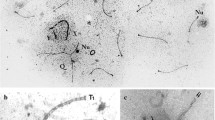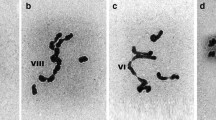Abstract
Pachytene analysis was undertaken in an infertile male heterozygous for two pericentric inversions of chromosomes 1 and 9. The synaptic behaviour of the bivalent 1 inversion was the most informative. Analysis of the chromomere pattern combined with centromeric heterochromatin staining allowed precise description of synaptic initiation and extension leading to the homosynapsed loop. These techniques also allowed demonstration of the existence of heterosynapsis following alignment of the inverted segments. Non-homologous synapsed bivalents had the morphological aspects of straight bivalents with two distant blocks of centromeric heterochromatin. The numbering of the autosomal bivalent chromomeres at various successive phases of the inversion loop behaviour of bivalent 1 permitted us an alternative approach to the timing of pachytene.
Similar content being viewed by others
References
Ashley T, Moses MJ, Solari AJ (1979) Electron microscopic analysis of the behaviour of a pericentric inversion in the sand rat (Psammomys obesus). Genetics 91:S2
Chandley AC (1982) A pachytene analysis of two male fertile paracentric inversions in chromosome 1 of the mouse and in the male-sterile double heterozygote. Chromosoma 85:127–135
De La Chapelle A, Schroder J, Stenstrand K, Fellman J, Herva R, Saarni M, Anttolainon I, Tallila I, Tervila L, Hursa L, Tallquist G, Robson EB, Cook PJL, Sanger R (1974) Pericentric inversions of human chromosomes 9 and 10. Am J Hum Genet 26:746–766
Ferguson-Smith MM (1973) Human autosomal polymorphism and the non-random involvement of chromosomes in translocations. In: Lewis KR (eds) Chromosomes Today 4:235–246
Geraedts JPM, Pearson PL (1974) Fluorescent chromosome polymorphisms: frequencies and segregations in a Dutch population. Clin Genet 6:247–257
Gillies CB (1974) The nature and extent of synaptonemal complex formation in haploïd barley. Chromosoma 48:441–453
Giraud F, Mattei JF, Mattei MG, Ayme S (1979) Les inversions péricentriques. A propos de 47 observations. J Genet Hum 27:109–122
Hauksdottir H, Halldorsson S, Jensson O, Mikkelsen M, McDermott A (1972) Pericentric inversion of chromosome number 13 in a large family leading to duplication deficiency causing congenital malformations in three individuals. J Med Genet 9:413–421
Luciani JM, Morazzani MR, Stahl A (1975) Identification of pachytene bivalents in human male meiosis using G-banding technique. Chromosoma 52:275–282
Luciani JM, Devictor M, Morazzani MR, Stahl A (1976) Meiosis of trisomy 21 in the human pachytene oocyte. Behaviour of the supernumerary chromosome, identification of chromomere sequence and numerous sub-bands. Chromosoma 57:155–163
Luciani JM, Guichaoua MR, Morazzani MR (1984). Complete pachytene chromomere karyotype of human spermatocyte bivalents. Hum Genet 66:267–271
Maguire MP (1965) The relationships of cross-over frequency to synaptic extent at pachytene in maize. Genetics 51:23–40
Maguire MP (1977) Homologous chromosome pairing. Phil Trans R Soc Lond B 277:245–258
Maguire MP (1981) A search for the synaptic adjustment phenomenon in maize. Chromosoma 81:717–725
Moses MJ (1977) Microspreading and the synaptonemal complex in cytogenetic studies. Chromosomes Today 6:71–82
Moses MJ, Poorman PA, Russell LB, Cacheiro NL, Roderick JH, Davisson MT (1978) Synaptic adjustment: Two pairing phases in meiosis. J Cell Biol 79:123a
Moses MJ, Karatsis PA, Hamilton AE (1979) Synaptonemal complex analysis of heteromorphic trivalents in Lemur hybrids. Chromosoma 70:141–160
Moses MJ, Poorman PA (1981) Synaptonemal complex analysis of mouse chromosomal rearrangements. II. Synaptic adjustment in a tandem duplication. Chromosoma 81:519–535
Moses MJ, Poorman PA, Roderick TM, Davisson MT (1982) Synaptonemal complex analysis of mouse chromosomal rearrangements IV. Synapsis and synaptic adjustment in two pericentric inversions. Chromosoma 84:457–474
Oud JL, de Jong JH, de Rooij DG (1979) A sequential analysis of meiosis in the male mouse using a restricted spermatocyte population obtained by a hydroxyurea/triaziquone treatment. Chromosoma 71:237–248
Oud JL, Reutlinger AHH (1981) Chromosome behaviour during early meiotic prophase of mouse primary spermatocytes. Chromosoma 83:395–407
Poorman PA, Moses MJ, Davisson MT, Roderick TH (1981) Synaptonemal complex analysis of mouse chromosomal rearrangements. III. Cytogenetic observations on two paracentric inversions. Chromosoma 83:419–429
Rasmussen SW (1977) Chromosome pairing in triploïd females of Bombyx mori analyzed by three dimensional reconstructions of synaptonemal complexes. Carlsberg Res Commun 42:163–167
Rasmussen SW, Holm PB (1979) Chromosome pairing in autotetraploïd Bombyx females. Mechanism for exclusive bivalent formation. Carlsberg Res Commun 44:101–125
Solari AJ (1980) Synaptonemal complexes and associated structures in microspread human spermatocytes. Chromosoma 81:315–337
Stahl A, Hartung M (1981) Heterochromatine. Ann Genet 24:69–77
Van Der Linden AGJM, Pearson PL, Van de Kamp JJP (1975) Cytological assessment of meiotic exchange in a human male with a pericentric inversion of chromosome n∘ 4. Cytogenet Cell Genet 14:126–139
Winsor EJT, Palmer CG, Ellis PM, Hunter JLP, Ferguson Smith MM (1978) Meiotic analysis of a pericentric inversion, inv(7) (p22q32) in the father of a child with a duplication deletion of a chromosome 7. Cytogenet Cell Genet 20:169–184
Author information
Authors and Affiliations
Rights and permissions
About this article
Cite this article
Guichaoua, M.R., Delafontaine, D., Taurelle, R. et al. Loop formation and synaptic adjustment in a human male heterozygous for two pericentric inversions. Chromosoma 93, 313–320 (1986). https://doi.org/10.1007/BF00327589
Received:
Issue Date:
DOI: https://doi.org/10.1007/BF00327589




